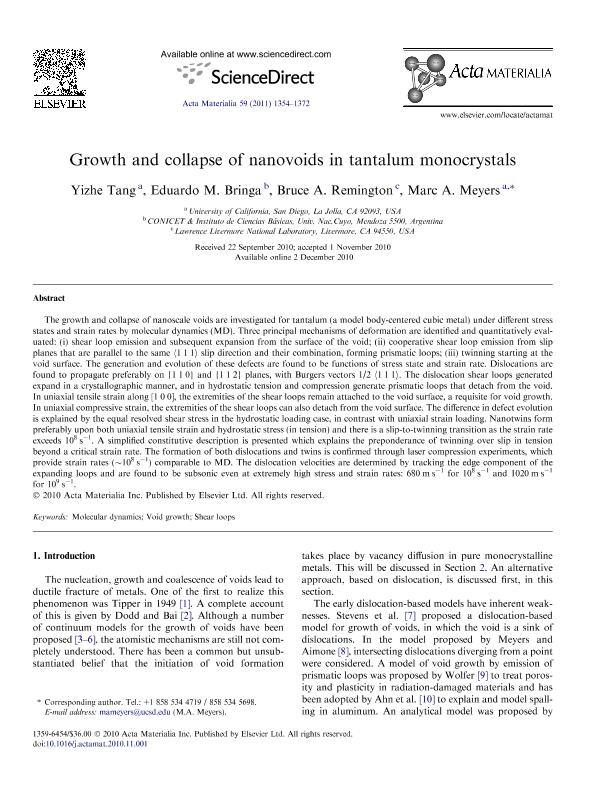Artículo
Growth and collapse of nanovoids in tantalum monocrystals
Fecha de publicación:
02/12/2010
Editorial:
Elsevier
Revista:
Acta Materialia
ISSN:
1359-6454
Idioma:
Inglés
Tipo de recurso:
Artículo publicado
Clasificación temática:
Resumen
The growth and collapse of nanoscale voids are investigated for tantalum (a model body-centered cubic metal) under different stress states and strain rates by molecular dynamics (MD). Three principal mechanisms of deformation are identified and quantitatively evaluated: (i) shear loop emission and subsequent expansion from the surface of the void; (ii) cooperative shear loop emission from slip planes that are parallel to the same h111i slip direction and their combination, forming prismatic loops; (iii) twinning starting at the void surface. The generation and evolution of these defects are found to be functions of stress state and strain rate. Dislocations are found to propagate preferably on {1 1 0} and {1 1 2} planes, with Burgers vectors 1/2 h111i. The dislocation shear loops generated expand in a crystallographic manner, and in hydrostatic tension and compression generate prismatic loops that detach from the void. In uniaxial tensile strain along [1 0 0], the extremities of the shear loops remain attached to the void surface, a requisite for void growth. In uniaxial compressive strain, the extremities of the shear loops can also detach from the void surface. The difference in defect evolution is explained by the equal resolved shear stress in the hydrostatic loading case, in contrast with uniaxial strain loading. Nanotwins form preferably upon both uniaxial tensile strain and hydrostatic stress (in tension) and there is a slip-to-twinning transition as the strain rate exceeds 108 s 1 . A simplified constitutive description is presented which explains the preponderance of twinning over slip in tension beyond a critical strain rate. The formation of both dislocations and twins is confirmed through laser compression experiments, which provide strain rates (108 s 1 ) comparable to MD. The dislocation velocities are determined by tracking the edge component of the expanding loops and are found to be subsonic even at extremely high stress and strain rates: 680 m s1 for 108 s 1 and 1020 m s1 for 109 s 1 . 2
Palabras clave:
Molecular Dynamics
,
Shear Loops
,
Void Growth
Archivos asociados
Licencia
Identificadores
Colecciones
Articulos(CCT - MENDOZA)
Articulos de CTRO.CIENTIFICO TECNOL.CONICET - MENDOZA
Articulos de CTRO.CIENTIFICO TECNOL.CONICET - MENDOZA
Citación
Tang, Yizhe; Bringa, Eduardo Marcial; Remington, Bruce A.; Meyers, Marc A.; Growth and collapse of nanovoids in tantalum monocrystals; Elsevier; Acta Materialia; 59; 4; 2-12-2010; 1354-1372
Compartir
Altmétricas




